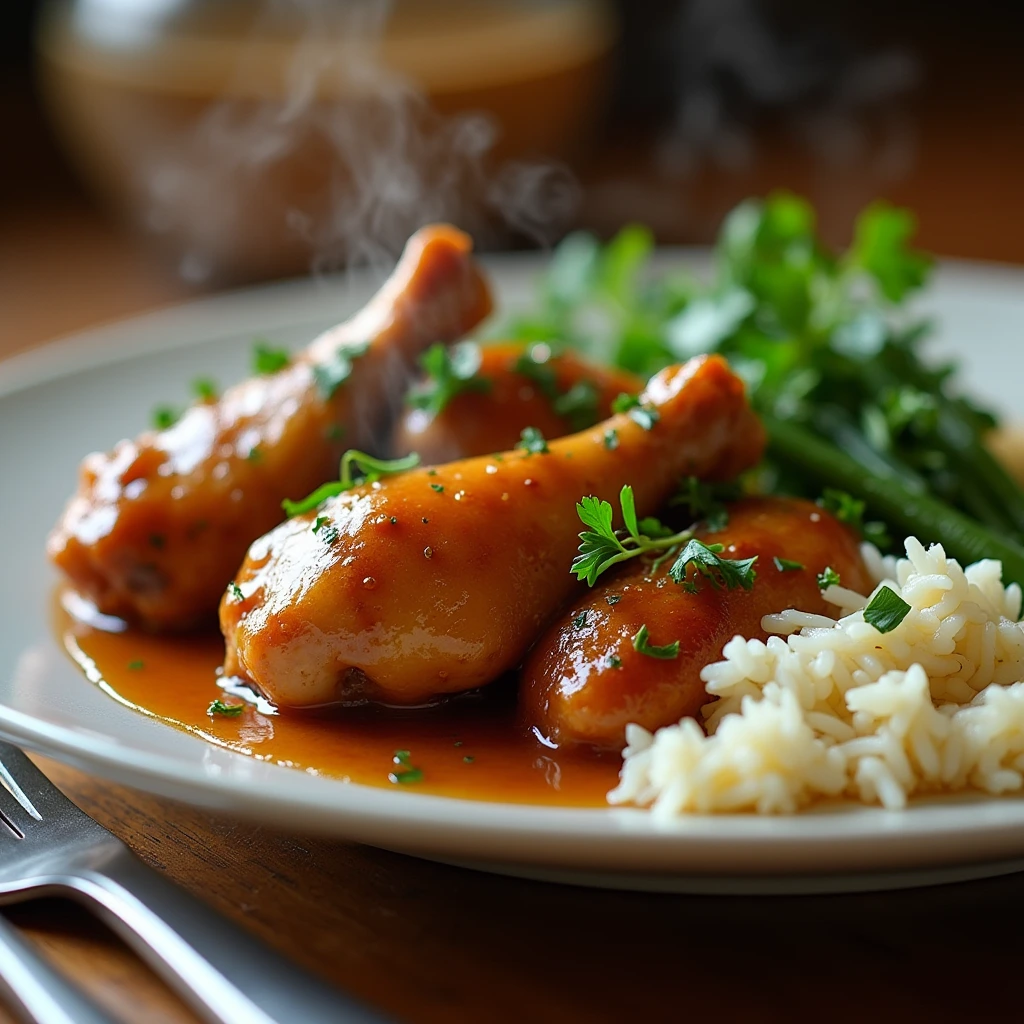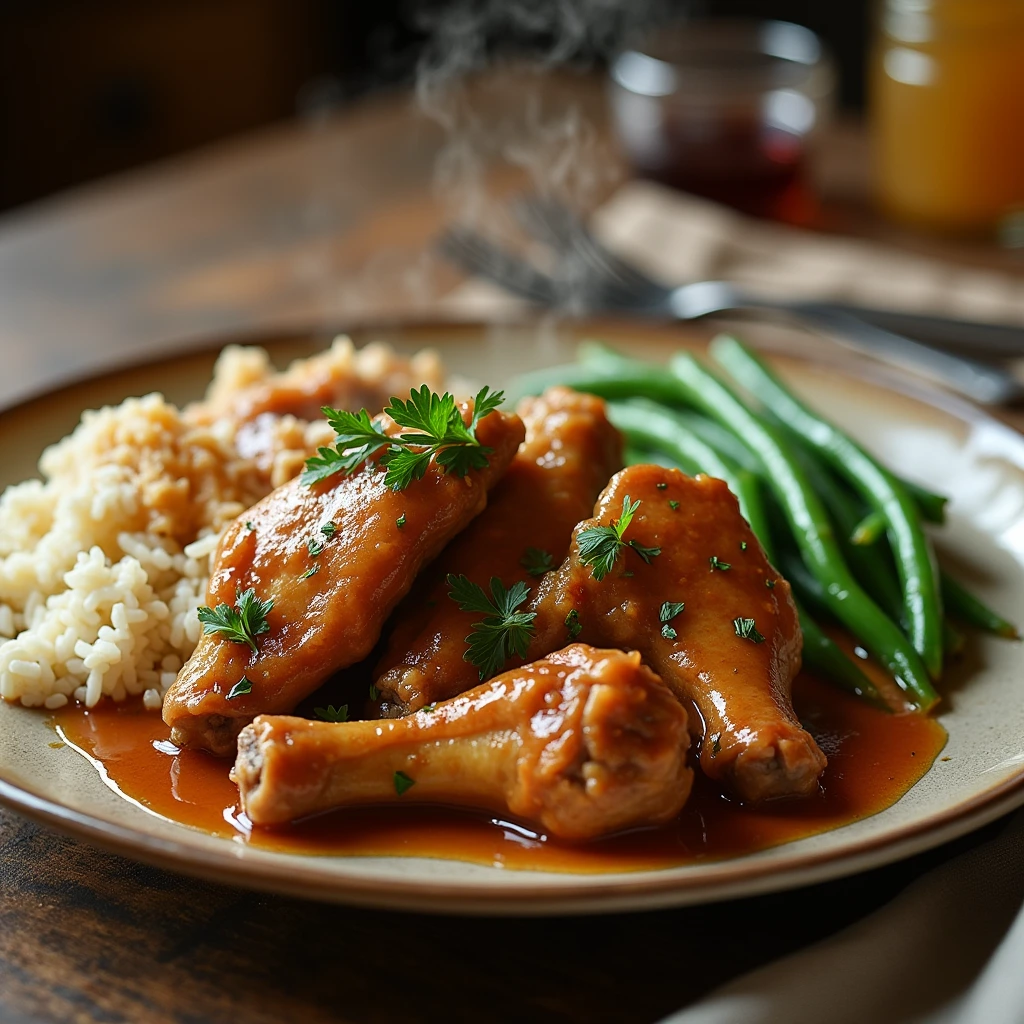Smothered turkey wings bring rich flavors and comforting appeal to Southern cuisine. This dish combines turkey wings with a savory, flavorful gravy, cooked slowly for tenderness. African American culinary traditions shaped the recipe, showcasing how simple ingredients can create delicious meals. Families have long served it as a symbol of love during gatherings and holidays.

This dish creates warmth and nostalgia, making it a favorite comfort food. Slow cooking enhances the flavors, ensuring every bite is deeply satisfying. Paired with rice, mashed potatoes, or cornbread, smothered turkey wings deliver the hearty and homemade qualities that define comfort food.
Ingredients Needed
To prepare smothered turkey wings, you’ll need the following ingredients:
- Turkey Wings: The star of the dish, providing tender, juicy meat and forming the base of the flavors.
- Onions: These not only add sweetness but also bring depth to the gravy.
- Bell Peppers: In addition, they enhance the dish with a subtle crunch and earthy flavor.
- Garlic: Furthermore, it boosts both the aroma and richness of the dish.
- Flour: This is essential for thickening the gravy, creating a smooth and creamy texture.
- Chicken or Turkey Broth: Moreover, it serves as a flavorful liquid base for the gravy.
- Butter: Additionally, it adds richness and gives the gravy a velvety finish.
- Seasonings (Salt, Pepper, Paprika, Thyme): These not only elevate the flavor but also provide a balanced mix of savory, smoky, and herbal notes.
- Oil (Vegetable or Olive): First, it is used for browning the wings and sautéing vegetables.
- Optional: Hot Sauce or Cayenne Pepper: Finally, these ingredients add a touch of heat for those who enjoy spice.
Together, these ingredients work harmoniously to create the hearty, flavorful essence of smothered turkey wings. With each component playing a unique role, the result is a comforting and satisfying dish.
Preparing the Turkey Wings
When preparing smothered turkey wings, selecting high-quality wings is crucial. Look for fresh wings with smooth skin and no discoloration. Fresh wings ensure better flavor and texture in the final dish.
Next, cleaning the wings properly is essential. Rinse them under cold water and pat them dry with a paper towel. For a more thorough clean, you can soak the wings in a mixture of water and a splash of vinegar or lemon juice. This helps remove any impurities and ensures a fresh taste.
Once cleaned, seasoning is the key to building flavor. Coat the wings with a blend of salt, pepper, paprika, garlic powder, and thyme. For added depth, include a hint of cayenne pepper or a splash of hot sauce if you enjoy a spicy kick.
Marination is optional but highly recommended for deeper flavor. Let the seasoned wings rest in the refrigerator for at least one hour, or overnight for best results. This allows the spices to penetrate the meat fully.
By carefully selecting, cleaning, and seasoning your turkey wings, you lay the foundation for a flavorful and satisfying dish. These steps ensure your wings are tender, tasty, and ready for smothering.
Making the Gravy
A rich, flavorful gravy is essential for smothered turkey wings. The key ingredients include butter, flour, chicken or turkey broth, onions, and seasonings like salt, pepper, and paprika. These create a savory base that complements the turkey perfectly.
To start, melt butter in a pan over medium heat. Gradually whisk in the flour to create a roux, stirring constantly until it turns golden brown. This step is crucial for a smooth and velvety texture. Slowly add the broth while continuing to whisk to avoid lumps. Let the mixture simmer until it thickens.
For added flavor, sauté onions and garlic in the roux before adding the broth. You can also incorporate bell peppers or mushrooms for a heartier gravy. For a more gourmet touch, a splash of white wine or a dollop of cream adds depth and richness.
Taste and adjust the seasonings as the gravy simmers. If it becomes too thick, thin it with a bit of broth. Once smooth and flavorful, pour the gravy over the prepared turkey wings. With these techniques and variations, your gravy will elevate the dish to a comforting, soul-warming masterpiece.
Cooking Smothered Turkey Wings
Cooking smothered turkey wings can be done on the stovetop or in the oven, each method offering delicious results. Stovetop cooking allows for easier monitoring, while oven baking gives a more hands-off approach and evenly cooked wings.
For tender, fall-off-the-bone turkey wings, low and slow cooking is key. Start by browning the wings in a skillet with oil over medium heat. This step locks in flavor and adds a golden crust. Transfer the wings to a pot (stovetop) or a baking dish (oven), then pour the prepared gravy over them.
On the stovetop, simmer the wings on low heat for 1.5 to 2 hours, ensuring the sauce doesn’t boil too rapidly. Alternatively, bake them in the oven at 350°F (175°C) for about 2 hours, covered with foil to keep the moisture in. Check occasionally and stir to ensure even cooking.
Maintaining proper temperature and timing is crucial. Overcooking can dry out the meat, while undercooking leaves it tough. The wings are ready when the meat easily pulls away from the bone. Whether stovetop or oven, this method ensures tender, flavorful wings smothered in savory gravy.
Serving Suggestions
Smothered turkey wings shine as the star of the meal, but pairing them with the right sides elevates the dish even further. Classic accompaniments include fluffy white rice, creamy mashed potatoes, or buttery cornbread, all of which soak up the rich, savory gravy beautifully. For a balanced plate, add collard greens, green beans, or roasted vegetables for a touch of freshness.
To enhance presentation, arrange the turkey wings neatly on a serving platter and generously drizzle them with gravy. Garnish with freshly chopped parsley or thyme for a pop of color and added aroma. Plating them over a bed of rice or mashed potatoes not only looks appealing but also makes serving easier.
For a rustic yet inviting presentation, serve the dish family-style in a cast-iron skillet or a deep dish, allowing guests to help themselves. If entertaining, consider pairing the meal with a crisp white wine or sweet tea to complement the savory flavors.
With thoughtful sides, garnishes, and presentation, smothered turkey wings transform into a memorable meal that’s as comforting as it is visually appealing.
Variations and Additions
Smothered turkey wings are versatile, allowing for flavorful twists to suit different preferences. For a spicy version, add cayenne pepper, red chili flakes, or hot sauce to the gravy. A touch of smoked paprika also enhances the heat while adding a smoky depth to the dish. Serve with cooling sides like coleslaw or cucumber salad to balance the spice.
For a cream-based gravy alternative, replace the broth with heavy cream or half-and-half for a rich, velvety texture. You can also mix in cream cheese or sour cream for added tang and indulgence. This variation pairs wonderfully with mashed potatoes or pasta for a decadent comfort meal.
To create a vegan or vegetarian substitute, swap turkey wings for large roasted mushrooms, jackfruit, or seitan. For the gravy, use vegetable broth, plant-based butter, and flour. Add nutritional yeast for a cheesy flavor or coconut milk for a creamy consistency. This plant-based version works well with quinoa or roasted sweet potatoes.
Whether you prefer spicy, creamy, or plant-based, these variations let you customize smothered turkey wings to suit any palate, ensuring everyone can enjoy this comforting dish.
Common Mistakes to Avoid
When making smothered turkey wings, a few common mistakes can compromise the dish’s flavor and texture. By keeping these tips in mind, you’ll ensure a perfect result every time.
Overcooking or Undercooking: Cooking turkey wings too long can dry out the meat, while undercooking leaves it tough and chewy. To avoid this, cook the wings low and slow—whether on the stovetop or in the oven—until the meat is tender and falls off the bone. Use a meat thermometer to ensure the internal temperature reaches 165°F (74°C).
Lumpy Gravy: A smooth gravy is crucial for this dish. Prevent lumps by whisking the flour thoroughly into melted butter when making the roux. Gradually add broth while stirring continuously to create a lump-free sauce. If lumps do form, strain the gravy through a fine sieve before serving.
Seasoning Balance: Over-seasoning can overwhelm the dish, while under-seasoning makes it bland. Taste and adjust as you go, ensuring a balance of salt, pepper, and spices. Remember, you can always add more seasoning, but it’s harder to fix an overly salty or spicy dish.
Avoiding these mistakes will guarantee flavorful, tender turkey wings with a silky, savory gravy every time.
Health and Nutritional Information
Smothered turkey wings are a hearty dish, but understanding their nutritional profile can help you enjoy them mindfully. A typical serving contains approximately 350–450 calories, depending on the portion size and ingredients used. Turkey wings are high in protein, providing around 25–30 grams per serving. However, they can also contain significant fat, especially from the skin, contributing 20–25 grams of fat, along with carbohydrates from the gravy and sides.
To make the dish healthier, consider a few ingredient substitutions. Reduce fat by removing the skin from the turkey wings before cooking. Use a small amount of olive oil instead of butter for the roux, or choose a plant-based butter alternative. For a lower-calorie gravy, opt for skim milk or unsweetened almond milk instead of cream, and use less flour or a cornstarch slurry to thicken the sauce.
If watching sodium intake, choose low-sodium broth and season lightly, letting diners add salt to taste. Pair the dish with whole grains like brown rice and steamed vegetables to boost fiber and nutrient content.
By making these substitutions, you can enjoy smothered turkey wings with fewer calories and more balanced nutrition without compromising flavor.
Storage and Reheating Tips
Proper storage and reheating ensure that leftover smothered turkey wings remain as delicious as the day they were made. To store leftovers, allow the dish to cool completely before transferring it to an airtight container. Store in the refrigerator for up to 3–4 days, or freeze for longer storage, up to 2–3 months. When freezing, separate the turkey wings and gravy into individual portions to make reheating easier.
When reheating, the goal is to retain moisture and avoid drying out the meat. For stovetop reheating, place the turkey wings and gravy in a pan over low heat, adding a splash of broth or water if the gravy has thickened too much. Cover the pan to help retain steam, reheating for 10–15 minutes until warmed through.
For microwave reheating, transfer a portion to a microwave-safe dish, cover with a microwave lid or damp paper towel, and heat on medium power in 1–2 minute intervals, stirring between intervals.
If reheating from frozen, thaw the dish overnight in the refrigerator before following the stovetop or microwave method. These tips will keep your smothered turkey wings tender, juicy, and full of flavor even as leftovers.
FAQs
What to eat with smothered turkey wings?
Smothered turkey wings pair well with classic sides like rice, mashed potatoes, or cornbread, which soak up the flavorful gravy. For a balanced meal, include greens such as collard greens, green beans, or a fresh side salad. Roasted vegetables or sweet potatoes also complement the dish beautifully.
Why do you soak turkey wings in vinegar?
Soaking turkey wings in vinegar helps clean the meat by removing impurities and any gamey odor. It also acts as a mild tenderizer, ensuring the wings remain juicy and flavorful during cooking. Rinse the wings thoroughly after soaking to avoid any residual vinegar taste.
How long does it take for turkey wings to cook?
Turkey wings typically take 1.5 to 2 hours to cook, whether on the stovetop or in the oven. Low and slow cooking ensures the meat becomes tender and absorbs the flavors of the gravy. Always check that the internal temperature reaches 165°F (74°C) for doneness.
Why are my turkey wings tough?
Tough turkey wings are often the result of undercooking or cooking at too high a temperature. Turkey wings require slow cooking over low heat to break down the connective tissues and become tender. Adding sufficient gravy and covering the dish helps retain moisture and prevent dryness.
More
For more recipes and culinary inspiration, visit the Quickly Taste homepage, which features a variety of dishes, from appetizers to desserts. If you enjoyed the idea of smothered turkey wings, you might also like exploring similar comforting recipes, such as the Old-Fashioned Stuffed Bell Peppers Recipe or the Frank’s Buffalo Chicken Dip Recipe. Additionally, for insights on preparing dishes for special occasions, check out their section on Christmas Dishes.
To expand your culinary horizons, external resources like AllRecipes or Epicurious offer valuable tips and a wide range of recipes to complement your cooking journey. Together, these internal and external resources provide a comprehensive guide for both everyday meals and festive feasts.
Conclusion
Smothered turkey wings are a comforting dish that brings together rich flavors, tender meat, and a savory gravy. From selecting quality ingredients and seasoning the wings to crafting a smooth, flavorful gravy and slow-cooking to perfection, the process is as enjoyable as the final result. With thoughtful preparation, this dish transforms into a soulful meal that’s perfect for family gatherings or quiet nights at home.
If you’ve never tried making smothered turkey wings, now is the time! The recipe is simple enough for beginners yet satisfying for seasoned cooks. Experiment with variations to suit your taste, whether you prefer a spicy kick, creamy gravy, or plant-based options. Each bite is a reminder of the love and care that goes into homemade comfort food.
Growing up, smothered turkey wings were a staple in our family dinners, always served with sides like fluffy rice and greens. The aroma filling the kitchen meant everyone would soon gather around the table. I hope this recipe inspires you to create similar cherished moments with your loved ones. Dive in and enjoy the journey of making—and savoring—this classic dish!

